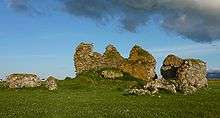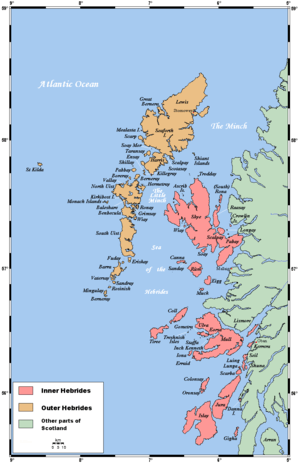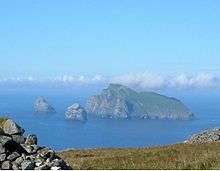Benbecula
| Gaelic name |
|
|---|---|
| Meaning of name | pennyland of the fords |
| Location | |
 Benbecula Benbecula shown within the Outer Hebrides | |
| OS grid reference | NF807525 |
| Physical geography | |
| Island group | Uists and Barra |
| Area | 8,203 hectares (31.7 sq mi) |
| Area rank | 16 [1] |
| Highest elevation | Ruaval 124 metres (407 ft) |
| Administration | |
| Sovereign state | United Kingdom |
| Country | Scotland |
| Council area | Na h-Eileanan Siar |
| Demographics | |
| Population | 1,303[2] |
| Population rank | 11 [1] |
| Pop. density | 15.9 people/km2[2][3] |
| Largest settlement | Balivanich |
| References | [3][4][5] |
Benbecula (/bɛnˈbɛkjᵿlə/; Scottish Gaelic: Beinn nam Fadhla,[6] or Beinn na Faoghla[7][8] pronounced [peɲəˈvɤːlˠ̪ə]) is an island of the Outer Hebrides, in the Atlantic Ocean off the west coast of Scotland. In the 2011 census it had a usually resident population of 1,303, with a sizable percentage of Roman Catholics. It forms part of the area administered by Comhairle nan Eilean Siar or the Western Isles Council.
Etymology
The first written record of the name is as "Beanbeacla" in 1449.[9] Historically this name is assumed to derive from Peighinn nam Fadhla (pronounced [pʰe.ɪɲəmˈfɤːlˠ̪ə]) "pennyland of the fords" as the island is essentially flat.[10] It is very similar phonetically to the unstressed form of Beinn ([peɲ] "mountain", and appears to have been subject to folk etymology or re-analysis, leading to the modern forms containing Beinn rather than Peighinn. Through a process of language assimilation, the [mˈfɤːlˠ̪ə] sequence has resulted in the modern pronunciation of [vɤːlˠ̪ə]. The spelling variations faola and fadhla are due to phonetic merger of /ɤ/ with /ɯ/ in certain Gaelic dialects. Spelling variants include: Beinn a' Bhaoghla, Beinn na Faoghla, Beinn na bhFadhla, Beinn nam Fadhla, Beinn nam Faola.
The second element is a loan from Norse vaðil(l) "ford" which was borrowed as Gaelic fadhail (genitive fadhla).[11] Through the process of reverse lenition fadhla, with the ethnonymic suffix -ach has led to the formation of Badhlach "a person from Benbecula".
Other interpretations that have been suggested over the years are Beinn Bheag a' bhFaodhla, supposedly meaning the "little mountain of the ford" and Beinn a' Bhuachaille, meaning "the herdsman's mountain".[3]
The island is also known in Gaelic poetry as An t-Eilean Dorcha "the dark island". The well-known tune The Dark Island was written by accordionist Iain MacLachlan from Benbecula.
Geography

The island is about 12 km from west to east and a similar distance from north to south. It lies between the islands of North Uist and South Uist; it is connected to both by road causeways. Travel to any of the other Hebridean islands, or to the British mainland, is by air or sea. Benbecula Airport on the island has daily flights to Glasgow, Stornoway and Barra. A direct service to Inverness was introduced in 2006 but discontinued in May 2007. There are no direct ferry services from Benbecula to the mainland, but a service operated by Caledonian MacBrayne from Lochboisdale on South Uist provides a five-hour crossing to Oban on the mainland, whilst another service from Lochmaddy on North Uist provides a two-hour crossing to Uig on the Inner Hebridean island of Skye, and hence to the mainland via the Skye Bridge. Ferry services from the islands of Berneray (linked by causeway to North Uist) and Eriskay (linked to South Uist) connect to the other Outer Hebridean islands of Harris and Barra respectively.
There is a dense cluster of lochs across almost the entire island, and almost all of the island is below 20 metres in altitude.
Settlements
Benbecula's main settlement is Balivanich (Scottish Gaelic: Baile a' Mhanaich, meaning "Town of the Monk") in the northwest. It is the main administrative centre for Benbecula, North Uist, South Uist and nearby islands, and has the council offices and the administrative centre for the artillery deep sea firing range on South Uist, which is managed by QinetiQ. The village is also home to the airport and the island's bank.
Other settlements include Craigstrome, a tiny hamlet in the south-east of Benbecula. In contrast to the cultivated west coast of the island, the eastern half is a mixture of freshwater lochs, moorland, bog and deeply indenting sea lochs. Craigstrome is near Ruabhal, Benbecula's highest hill at 124 metres (407 ft).
The township of Lionacleit houses the Uists' main secondary school, which also doubles as a community centre, with a swimming pool, cafeteria, sports facilities, a small museum and a library.[12] Next door to this is the Lionacleit campus of Lews Castle College. Lionacleit lies on the west coast road, about 1 mile from its junction with the north-south spinal road near Creagorry.
Creagorry is in the south of the island, near the causeway to South Uist. The Co-op here is the main supermarket for the south of the island and for the north of South Uist. Borve Castle is near Lionacleit.
The RAF radar station RRH Benbecula monitors the northern Atlantic, but is located on the west coast of North Uist.
Nearby islands

In addition to the Uists there are numerous islands off the north, east and south coasts. To the north of Balivanich is Baleshare, and further east is Flodaigh, which is connected to Benbecula by another causeway. Beyond Flodaigh are Grimsay and Ronay. Off the east coast there are numerous small islands in Loch Uisgebhagh and beyond, including Bearran and Orasaigh Uisgeabhagh. Eileanan Chearabhaigh[13] in the south east have a total area of 100 hectares (250 acres) spread over several islands, the largest of which is about 31 hectares (77 acres) in extent. Further south is the larger Wiay and west from there a profusion of skerries and small islands lie to the north of Bagh nam Faoileann. These include Fraoch-eilean, a second Grimsay, Fodragaigh, Eilean na Cille and Triallabreac.
History

Borve Castle is a ruined 14th century tower house, located at the south-west of the island. MacGibbon and Ross attributed the building of the tower to Amie MacRuari, the divorced wife of John of Islay, and dated its construction to between 1344 and 1363.[14][15] It was occupied by the Macdonalds of Benbecula until the early 17th century.
In the early 15th century Hugh MacDonald, third son of Alexander, Earl of Ross was the proprietor of "lands in Uist, Benbecula and Garmoran" although his tenure was opposed by Clanranald of Garmoran.[16] By 1491 Clanranald were in possession of "nearly the whole of Uist and Benbecula".[17]
In 1549, Donald Monro, Dean of the Isles wrote of the "south part of Ywst" and went on:
and in the north syde of this there is ane parochin callit Buchagla, perteining to the said Clandonald. At the north end thereof the sea cuts the countrey againe, and that cutting of the sea is called Careynesse, and benorth this countrey is called Kenehnache of Ywst, that is in Englishe, the north head of Ywst.[18]
"Buchagla" is a reference to Benbecula and Beandmoyll, Beanweall, and Benvalgha are other variants found in charters.[19]
A mermaid, discovered in 1830, is reportedly buried near the sea at Benbecula.[20]
Gaelic speakers
Benbecula has historically been a very strong Gaelic-speaking area. Both in the 1901 and 1921 census, all parishes were reported to be over 75% Gaelic speaking. By 1971, Benbecula and South Uist were classed as 50-74% Gaelic-speaking.[10]
It remains a relatively strong Gaelic-speaking area in spite of a continued decline. In the 2001 census, Benbecula overall had 56% Gaelic speakers. The weakest Gaelic-speaking area is Balivanich with only 37%. All other areas on Benbecula range between 74% (Lionacleit) and 62% (Gramsdale and Uachdar).[10]
Community buy-out
After a protracted campaign, local residents took control of parts of the island on 30 November 2006 in a community buy-out. The previous landowners, a sporting syndicate, sold the assets of the 372 square kilometres (92,000 acres) estate including Benbecula, South Uist and Eriskay for £4.5 million to a community-owned organisation known as Stòras Uibhist which was set up to purchase the land and to manage it in perpetuity.[21][22][23]
In 2001 the census recorded a population of 1,219[24] the 2011 total of 1,303 being an increase of 7% against an average of 3% for all Scottish islands.[2]
Notes
- 1 2 Area and population ranks: there are c. 300 islands over 20 ha in extent and 93 permanently inhabited islands were listed in the 2011 census.
- 1 2 3 National Records of Scotland (15 August 2013) (pdf) Statistical Bulletin: 2011 Census: First Results on Population and Household Estimates for Scotland - Release 1C (Part Two). "Appendix 2: Population and households on Scotland’s inhabited islands". Retrieved 17 August 2013.
- 1 2 3 Haswell-Smith (2004) p. 236
- ↑ Ordnance Survey. Get-a-map (Map). 1:25,000. Leisure. Ordinance Survey. Retrieved 21 August 2013.
- ↑ "Welcome to Benbecula" Explore Scotland. Retrieved 19 August 2008.
- ↑ Mac an Tàilleir, Iain (2003) Placenames Archived December 25, 2010, at the Wayback Machine.. (pdf) Pàrlamaid na h-Alba. Retrieved 20 August 2008.
- ↑ "Benbecula - Beinn na Faoghla". Ainmean-Àite na h-Alba - Gaelic Place-Names of Scotland - Database. Retrieved 2015-06-06.
- ↑ "Benbecula". Am Faclair Beag - Scottish Gaelic Dictionary. Retrieved 2015-06-06.
- ↑ "Benbecula". Encyclopedia.com quoting Mills, A.D. (2003) A Dictionary of British Place-Names. Retrieved 16 April 2011.
- 1 2 3 Mac an Tàilleir, Iain (2004) 1901-2001 Gaelic in the Census (PowerPoint ) Linguae Celticae. Retrieved 1 June 2008.
- ↑ Oftedal, M. The Gaelic of Leurbost Norsk Tidskrift for Sprogvidenskap 1956
- ↑ "Sgoil Lionacleit" Comhairle nan Eilean Siar. Retrieved 4 July 2010.
- ↑ At grid reference NF866476
- ↑ "Borve Castle, NMRS Number: NF75SE 12". RCAHMS. Retrieved 16 April 2011.
- ↑ Gregory (1881) p. 29
- ↑ Gregory (1881) p. 60
- ↑ Gregory (1881) p. 66
- ↑ Monro (1549) "Ywst" No. 154
- ↑ MacLuachlan, Rev. Thomas. "On the Kymric Element in the Celtic Topography of Scotland". (Jan 1866) Proceedings of the Society of Antiquaries of Scotland. VI p. 318
- ↑ "1830: Mermaid near Benbecula, Outer Hebrides, Scotland - Think AboutIt". Think AboutIt. Retrieved 29 July 2014.
- ↑ "Land buyout reality for islanders". BBC News. 30 November 2006. Retrieved 4 January 2010.
- ↑ "Stòras Uibhist: Going Forward Together" storasuibhist.com. Retrieved 26 June 2010.
- ↑ The quiet revolution. (19 January 2007) Broadford. West Highland Free Press.
- ↑ General Register Office for Scotland (28 November 2003) Scotland's Census 2001 – Occasional Paper No 10: Statistics for Inhabited Islands. Retrieved 26 February 2012.
References
- Gregory, Donald (1881) The History of the Western Highlands and Isles of Scotland 1493 - 1625. Edinburgh. Birlinn. 2008 reprint - originally published by Thomas D. Morrison. ISBN 1-904607-57-8
- Haswell-Smith, Hamish (2004). The Scottish Islands. Edinburgh: Canongate. ISBN 978-1-84195-454-7.
- Monro, Sir Donald (1549) Description of the Western Isles of Scotland. William Auld. Edinburgh - 1774 edition.
External links
- Sgoil Lionacleit
- Explore Benbecula
- Am Paipear Community Newspaper
- Island News and Advertiser Popular Free Newspaper
- Benbecula Community News, Tourism and Local Benbecula Events
- Map sources for Benbecula
 Benbecula travel guide from Wikivoyage
Benbecula travel guide from Wikivoyage
Coordinates: 57°26′45″N 7°19′11″W / 57.44580°N 7.31964°W

